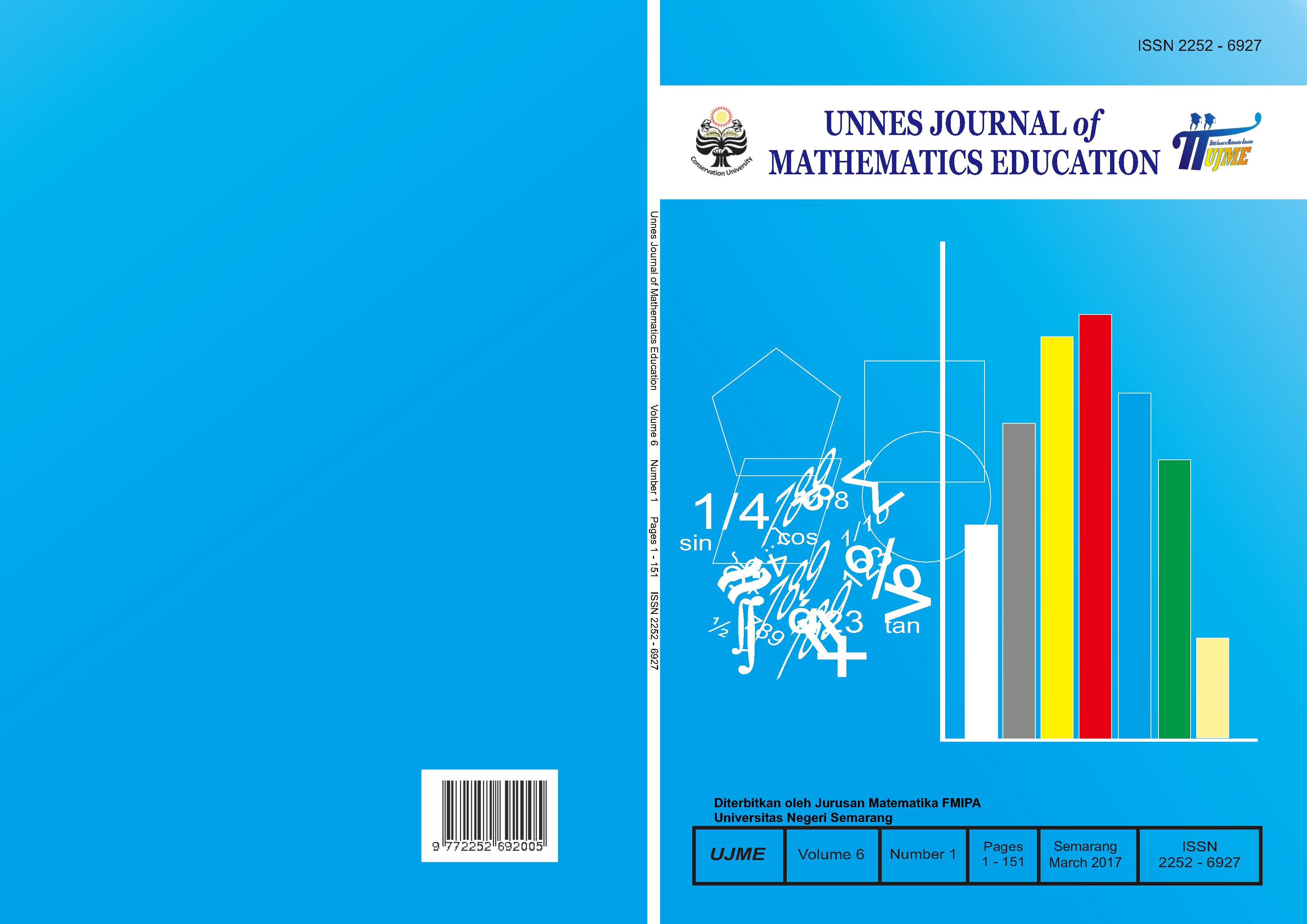Analysis of Mathematical Communication Skills and Confidence of 10th Grader of SMK in Geometry Material Viewed from Cognitive Style
##plugins.themes.academic_pro.article.main##
Abstract
The purpose of this study were to describe the mathematical communication skills and the confidence of grade X SMK students on Van Hiele model geometry learning based on their cognitive styles. It was a qualitative descriptive research. The subjects were 2 impulsive students and 2 reflective students which were selected with MFFT instrument. The data collection techniques were mathematical communication skills tests (written and orally), interviews, documentation, attitude scale and activity observation sheets. The results showed that both written and orally, reflective students were able to meet 5 indicators of mathematical communication skills, and less meet another indicators. While, impulsive students less meet all of the mathematical communication skills indictors. The impulsive students confidence was in the medium category. In contrary, the reflective students confidence was in the high category.
##plugins.themes.academic_pro.article.details##
References
Bassey, S. W . & Umoren, G. (2009). Cognitive Style, Secondary School Students’ Attitude and Academyc Performance In Chemistry In Akwa Ibom State – Nigeria. www.hbsce.tifr.res.in, diakses pada tanggal 17 Desember 2016.
Brumfiel, C. F ., dkk. (1960). Geometry. USA: Addi-son-Wesley Publishing Compani, Inc.
Budiono, C.S., & Wardono. (2014). PBM Berorientasi PISA Berpendekatan PMRI Bermedia LKPD Meningkatkan Literasi Matematika Siswa SMP. Unnes Journal of Mathematics Education, 3 (3) diakses pada tanggal 9 September 2016.
Clements, D. H. & Battista, M. T. (1992). Geometry and Spatial Reasoning. In D. A. Grows (Ed.), Handbook of research on mathematics teaching and learning (pp. 420-464). New York: Macmillan.
Depdiknas. (2006). Kurikulum Tingkat Satuan Pendidikan. Jakarta: Depdiknas.
De Angelis, B. (1997). Konfidence Percaya Diri Sumber Sukses dan Kemandirian. Jakarta: PT. Gramedia Pustaka Utama.
Fatimah, E. (2006). Psikologi Perkembangan. Bandung: CV . Pustaka Setia. Kerami, D., dkk. (2003). Kamus Matematika. Jakarta: Balai Pustaka.
Hambly, K. (1992). Bagaimana Cara Meningkatkan Percaya Diri. Jakarta: Arcan.
Kagan, J. (1965). Reflection Impulsivity and Reading Ability in Primary Grade Children, Children Developtment, 36: 609-628.
NCTM. (1989). Princples and Standards for School Mathmatics. Reston: The Nation Council of Teachers of Mathematics, Inc.
NCTM. (2000). Princples and Standards for School Mathmatics. Reston: The Nation Council of Teachers of Mathematics, Inc.
Nuraeni, E. (2008). Teori Van Hiele dan Komunikasi Matematik (Apa, Mengapa Dan Bagaimana). Tasikmalaya: UPI, diakses pada tanggal 20 Desember 2015.
Pertiwi, D. D., dkk. (2013). Kemampuan Komunikasi Matematis dalam Pemecahan Masalah Matematika sesuai dengan Gaya Kognitif pada Siswa Kelas IX SMP Negeri 1 Surakarta Tahun Pelajaran 2012/2013, disajikan di www.jurnal.fkip.uns.ac.id/ index.php/s2math/article/view/3525, diakses pada tanggal 20 Desember 2015.
Van Hiele, P . H. (1959). Levels of Metal Development in Geometry, disajikan di www.math.uiuc.edu diakses pada tanggal 20 Desember 2015.
Rahmat, J. (2000). Psikologi Agama. Jakarta: Raja Grafindo Persada.
Salirawati, D. (2012). Percaya Diri, Keingintahuan, dan Berjiwa Wirausaha: Tiga Karakter Penting Bagi Peserta Didik. Jurnal Pendidikan Karekter II tahun 2.
Santrock, J. W . (1997). LifeÂSpan Development Edisi keenam. (editor: Brown & Benchmark). Dallas: University of Texas.
Sugiyono. (2012). Metode Penelitian Pendidikan. Bandung: Alfabeta.
Suherman, E., dkk. (2003). Strategi Pembelajaran Kontemporer. Bandung: UPI.
Sukmadinata, N. S. (2009). Metode Penelitian Pendidikan. Bandung: PT Remaja Rosdakarya.
Wardhani, S. dan Rumiati. (2011). Istrumen Penilaian Hasil Belajar Matematika SMP; dari PISA dan TIMSS. Yogyakarta: KPN: PPPPTKM, diakses tanggal 20 Desember 2015.
Wardono. (2013). Peningkatan Literasi Matematika Melalui Pembelajaran Inovatif Berpenilaian Programme for International Student Assessment. http://conf.unnes.ac.id/, diakses pada tanggal 9 September 2016.
Wardono et al. (2016). Mathematics Literacy on Problem Based Learning with Indonesian Realistic Mathematics Education Approach Assisted EÂLearning Edmodo. http://iopscience.iop.org /17426596/693/1/012014, diakses pada tanggal 13 September 2016.
Warli. (2010). Profil Kreativitas Siswa yang Bergaya Kognitif Reflektif dan Siswa yang Bergaya Kognitif Impulsif dalam Memecahkan Masalah Geometri. Disertasi tidak diterbitkan. Surabaya: PPS-Unesa.
